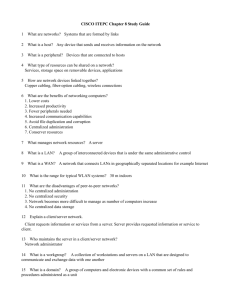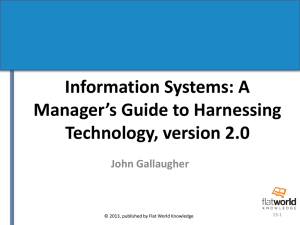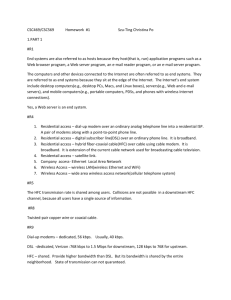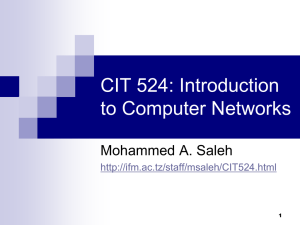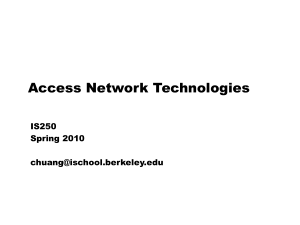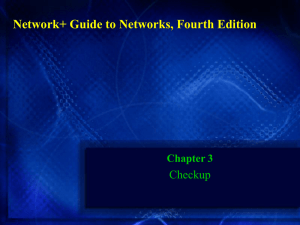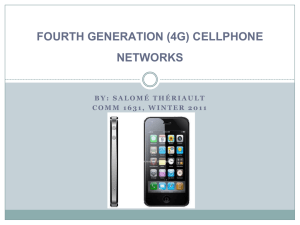NetworkQuesSol
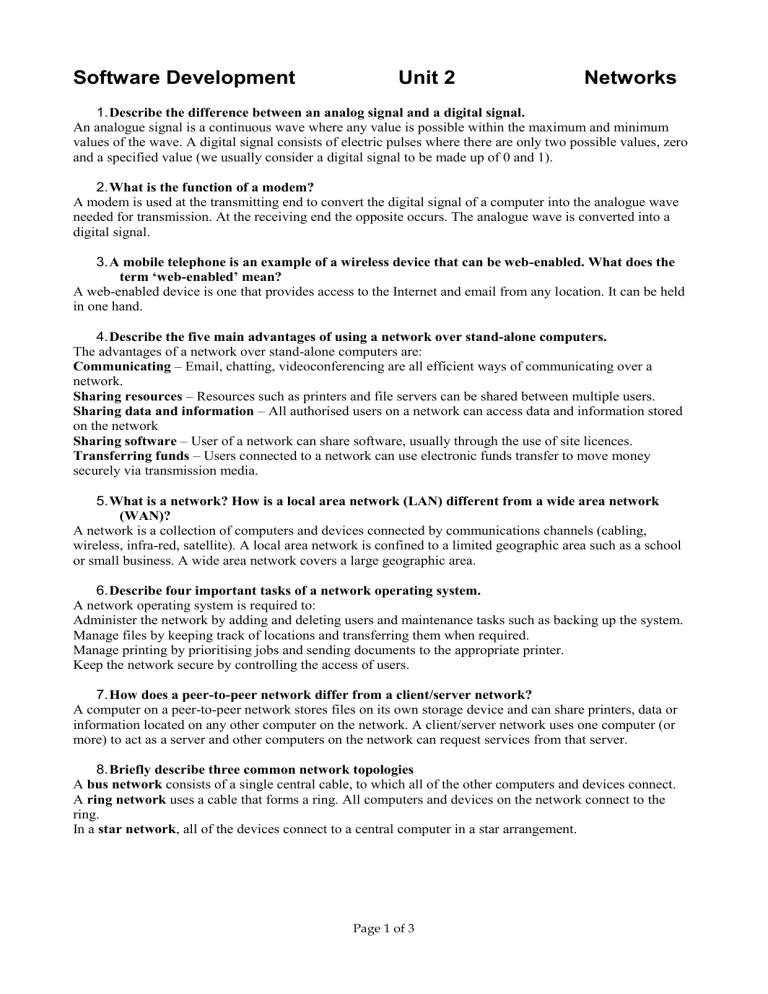
Software Development Unit 2 Networks
1.
Describe the difference between an analog signal and a digital signal.
An analogue signal is a continuous wave where any value is possible within the maximum and minimum values of the wave. A digital signal consists of electric pulses where there are only two possible values, zero and a specified value (we usually consider a digital signal to be made up of 0 and 1).
2.
What is the function of a modem?
A modem is used at the transmitting end to convert the digital signal of a computer into the analogue wave needed for transmission. At the receiving end the opposite occurs. The analogue wave is converted into a digital signal.
A web-enabled device is one that provides access to the Internet and email from any location. It can be held in one hand.
3.
A mobile telephone is an example of a wireless device that can be web-enabled. What does the term ‘web-enabled’ mean?
4.
Describe the five main advantages of using a network over stand-alone computers.
The advantages of a network over stand-alone computers are:
Communicating – Email, chatting, videoconferencing are all efficient ways of communicating over a network.
Sharing resources – Resources such as printers and file servers can be shared between multiple users.
Sharing data and information – All authorised users on a network can access data and information stored on the network
Sharing software – User of a network can share software, usually through the use of site licences.
Transferring funds – Users connected to a network can use electronic funds transfer to move money securely via transmission media.
5.
What is a network? How is a local area network (LAN) different from a wide area network
(WAN)?
A network is a collection of computers and devices connected by communications channels (cabling, wireless, infra-red, satellite). A local area network is confined to a limited geographic area such as a school or small business. A wide area network covers a large geographic area.
6.
Describe four important tasks of a network operating system.
A network operating system is required to:
Administer the network by adding and deleting users and maintenance tasks such as backing up the system.
Manage files by keeping track of locations and transferring them when required.
Manage printing by prioritising jobs and sending documents to the appropriate printer.
Keep the network secure by controlling the access of users.
7.
How does a peer-to-peer network differ from a client/server network?
A computer on a peer-to-peer network stores files on its own storage device and can share printers, data or information located on any other computer on the network. A client/server network uses one computer (or more) to act as a server and other computers on the network can request services from that server.
8.
Briefly describe three common network topologies
A bus network consists of a single central cable, to which all of the other computers and devices connect.
A ring network uses a cable that forms a ring. All computers and devices on the network connect to the ring.
In a star network , all of the devices connect to a central computer in a star arrangement.
Page 1 of 3
9.
Which of the network topologies is most suited to environments where devices may need to be added or removed on a regular basis? Why?
A star network is most suited to an environment where computers or devices may be regularly added or removed from the network since there is no central cable and therefore no disconnection across the whole network if one channel is temporarily unavailable.
10.
What is an intranet? What benefits to organisations are there is setting up an intranet?
An intranet is an internal network in an organisation that uses Internet and Web protocols to securely share information and policies with employees. Intranets restrict access to company information and facilities to employees.
11.
Briefly describe how an Ethernet network transmits data.
A workstation on an Ethernet network broadcasts a packet of data when the network is not busy. The packet is received by all workstations on the network, but only the workstation the packet is addressed to will read it. If two workstations send a message at precisely the same time a collision occurs. Each workstation waits a random amount of time before re-sending the packet.
12.
In what situations would the TCP/IP protocol be most useful?
The TCP/IP protocol breaks data down into very small packets. This allows the packets to travel of multiple routes to the destination. This makes it ideal for use on a WAN such as the Internet where there a numerous different paths a packet can take. The protocol is also being use don LANs, however these usually have only one path to the destination and the advantage of small size is lost.
13.
Explain the term ‘packet switching’.
Packet switching is the process of breaking a message into individual packets, sending the packets along the best route available, and then reassembling the data at the destination.
14.
What network transmission standard would be useful in a situation where an old, heritagelisted building with solid stone walls needs to be networked?
The 802.11 standard would be best in an environment where penetrating walls with cable would be a problem. The 802.11 standard uses wireless transmission.
15.
Describe how verifying the identity of a user can protect a network.
Verifying the identity of a user through a user name and password system restricts access to authorised people only. This stops people who are not recognized by the system from accessing or changing data or files on the network.
16.
What is a firewall?
A firewall is hardware and/or software that restricts access to data and information on a network. It is placed between the network’s servers and the outside communication channel.
17.
Describe three measures that should be incorporated into a wireless network to restrict access by unauthorised users and to secure the transmission of data.
A firewall should be used to block server ports thus restricting access to outsiders to the network. Wireless access points should be configured so that they do not broadcast a network name. Data transmitted over the wireless network should be encrypted so that if unauthorized access does occur, the data will be meaningless.
18.
Some communications software support file transfer protocol (FTP). What is the purpose of
FTP?
File transfer protocol (FTP) is an Internet standard that allows a user to upload and download files to and from a Web-server.
19.
What is the purpose of a network interface card?
A network interface card packages data for transmission and controls access to and from the network cable.
Page 2 of 3
20.
A wireless access point can be wired to the fibre-optic backbone of a bus network. What is the purpose of the wireless access point?
A wireless access point allows computers and devices to transmit data wirelessly among themselves. The transmission of data from a wireless access point back to a server is made faster if it is connected to a wired backbone.
21.
Routers and switches are used to connect separate networks. Explain the circumstances in which each of these would be used.
A router is able to connect networks running different network communications protocols. A switch stores the address of each device down every cable connected to it, so it is able to use logic to send packets directly to the destination device rather than broadcasting to all devices.
22.
What is the difference between baseband and broadband transmission?
Baseband transmission involves only one signal at a time. Broadband transmission uses multiple signals simultaneously.
23.
What is the advantage of using coaxial cable over twisted-pair wire? When would you use twisted-pair?
Coaxial cable uses a copper braid to shield the centre conductor from electrical noise. It therefore has an advantage over twisted pair in that it can be used in areas where there is likely to be electrical interference and over larger distances. Twisted pair is cheaper than coaxial cable and is useful in connecting devices over short distances away from electrical interference, such as in a home network.
24.
What advantage does fibre-optics have over wire cables?
Fibre-optic cable uses light to transmit data. It is, therefore, unaffected by electrical interference and can be used over large distances with negligible loss of signal.
25.
In what circumstances would a network designer consider using wireless transmission media?
Wireless transmission is used when it is cheaper to install than wired cables, if portability is a major requirement or when it is impractical or impossible to install cables.
26.
What is the main limitation of microwave transmission?
Microwave transmission requires line-of-sight communication. If there are any buildings, trees or other objects between the transmitter and the receiver the transmission will be blocked. This can become a problem if a new building is constructed in the current line-of-sight of an existing microwave network.
27.
Describe the advantages of setting up a home network
A home network allows all computers in the house to be connected to the Internet at the same time. All computers can also access files on any computer and share resources such as printers or DVD drives.
Page 3 of 3
